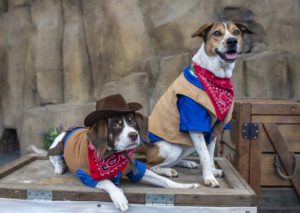
On the stage at the Wild Wonders Outdoor Theater, two dogs are waiting to ride a “hot air balloon” (actually, a basket and beach ball on a cable). One, with dark brown patches and a blue bandanna round his neck, sits patiently – then hops inside confidently. The other dog, lighter brown with a purple bandanna, sniffs around excitedly.
The theater’s summer show begins May 4, and this year the lead role will be shared by veteran Herald and youngster Mazie Mae.
And that means a lot of training.
Sit, fetch, recycle
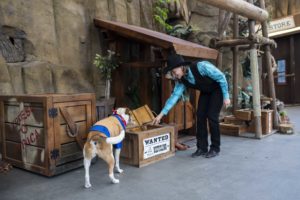
“Herald is really food-motivated, so that makes training easier,” says Adrienne Umpstead, a Wild Wonders staff biologist who works with both dogs, as well as other animals in the show. “So is Mazie, but she’s younger and also loves people…so that’s more distracting. But they both know the routine well by now. The hardest part for Mazie is just dialing back the enthusiasm!”
While they look similar, Herald and Mazie aren’t actually related, and have very distinct personalities. Both are mixed-breed dogs adopted from rescue facilities; but Herald has been at the Zoo for nine years, and is more sedate at 12 years old, while two-year-old Mazie arrived last spring.
Since then, the Wild Wonders staff have been working with her on good people skills and leash manners, plus training the behaviors she needs both for Zoo life and her stage role – “Sheruff” Bones in the fictional Wild West town of Triple R, where the motto is “Choose to Reuse.”
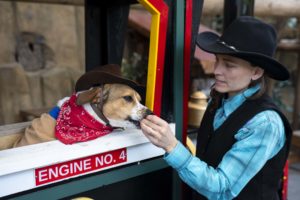
“We use positive reinforcement to train all our animals,” explains Umpstead. “That means we reward behaviors that we want, and ignore ones we don’t want.”
For Herald and Mazie, that reward mostly comes in the form of edible treats – peanut butter, cheese bites, chicken and dog kibble – although physical and verbal affection can work just as well for some animals. Trainers use a clicker to communicate to the animal when the requested behavior is done, so they know a treat is on the way (an important thing during a stage show).
Training a new behavior can be tricky. Some, like fetching a ball, can be shaped by rewarding actions that get increasingly close to the goal. Others, like barking, have to be “captured,” or rewarded when they happen spontaneously.
The animal soon figures out which behaviors get rewarded, and does them on cue. The whole process can take days, weeks or months, depending on the animal and the behavior. (Take the “train engine” the dogs ride during the show: Herald was easily convinced by a smear of peanut butter just inside, while Mazie needed weeks of step-by-step training time, with rewards for standing near it, then climbing inside, then finally riding across the stage.)
Cueing animal care
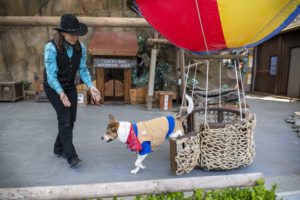
Of course, the other animals in the show are also trained, though only for behaviors they would do naturally in the wild. Siesta the sloth climbs off a keeper onto a tree branch, Scooter runs across the stage in search of treats, Orchid the clouded leopard climbs onto branches and Twiggy the red-legged seriema has possibly the most popular cameo: whacking a rubber frog on the ground as she would her actual prey.
But it’s not just about the show. Positive reinforcement training is crucial at Wild Wonders and all around the Zoo to help animals participate in their own health care: holding still for a blood sample, opening a mouth wide for a dental check.
Right now, one week before show time, Herald and Mazie have come on stage after the Close Encounter to rehearse in front of an audience. Keepers ask them to sit, fetch, lie down, roll in a blanket and open a door. Herald does every action without question, paying close attention to cues. Mazie’s fast and eager, always ready for the next thing.
Finally, they’re asked to sit at the edge of the stage so Zoo guests can meet and pat them. Mazie clearly loves this part, and she finds it hard to keep still with so many interesting people around.
Making animal connections
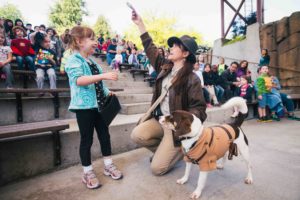
It’s clear that this is also the part the kids love. Waiting patiently for a turn, they tell keepers all about their own pets, dogs they’ve seen, other animals.
“Kids really connect with them: they’re relatable, touchable, charismatic,” explains Umpstead. “People remember Herald’s name, and one kid even brought in a stuffed toy he’d named after him. This is why we have dogs at the Zoo – so we can use them to talk about animal needs in general, and about good pet choices.”
Behind the scenes at the Wild Wonders theater, Herald wanders up to an orange tape line on the floor that separates the kitchen from the area where the other animal ambassadors live: lynx, armadillo, sloth, coendou. Well-trained, he stops and turns around; he knows the line means “no dogs allowed”. But Mazie, ever curious, wanders slowly over the line, glancing guiltily over her shoulder.
“Miss Mazie!” calls a keeper. The dog returns, tail wagging.
“Good job!” comes the response, and a quick cuddle.
SEE THEM: See Herald and Mazie in the Wild Wonders Outdoor Theater live animal show, opening May 4. (They’ll take turns.) Also new in the show will be Nigel the coendou and Terra the tamandua.
HOURS: Pre-show 11:45am, show 12pm daily; pre-show 3:15pm, show 3:30pm Sat-Sun from May 4. (From May 4-Sept. 2, both shows happen daily.)
LEARN MORE: On the Wild Wonders page here.